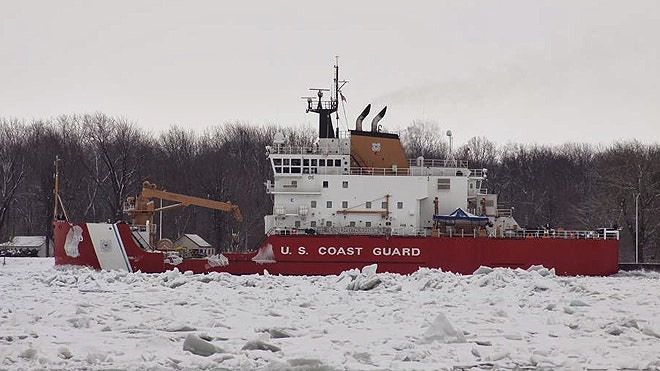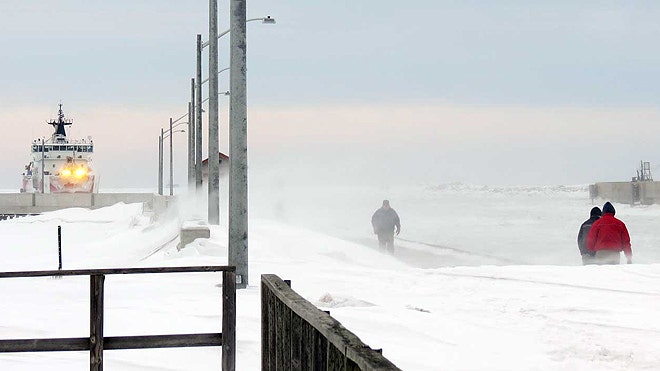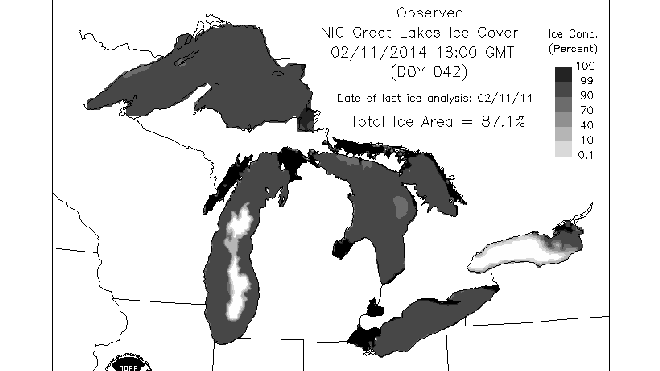http://www.foxnews.com/weather/2014/02/12/brutal-winter-may-see-lake-superior-freeze-over-for-first-time-in-decades/ Brutal winter may see Lake Superior freeze over for first time in decades Published February 12, 2014 FoxNews.com
-
 The bitter cold is making for tough travel on the Great Lakes, which are nearly 90 percent covered by ice, according to the National Oceanographic and Atmospheric Administration. (Courtesy: BoatNerd.com)
The bitter cold is making for tough travel on the Great Lakes, which are nearly 90 percent covered by ice, according to the National Oceanographic and Atmospheric Administration. (Courtesy: BoatNerd.com) -
 The U.S. Coast Guard's Mackinaw is the only heavy ice-breaking vessel assigned to the Great Lakes. It sports state-of-the-art systems, including servicing buoys, search & rescue capabilities and the ability to deploy an oil skimming system to respond to spill events. (Courtesy: BoatNerd.com)
The U.S. Coast Guard's Mackinaw is the only heavy ice-breaking vessel assigned to the Great Lakes. It sports state-of-the-art systems, including servicing buoys, search & rescue capabilities and the ability to deploy an oil skimming system to respond to spill events. (Courtesy: BoatNerd.com) -
 Shipping on the Great Lakes operates on a 42-week season to deliver 150 million tons of materials, according to Coast Guard officials. Of those 42 weeks, 12 weeks typically require icebreaking services. (Courtesy: Kenneth E. Bailey, Jr./Michigan Exposures)
Shipping on the Great Lakes operates on a 42-week season to deliver 150 million tons of materials, according to Coast Guard officials. Of those 42 weeks, 12 weeks typically require icebreaking services. (Courtesy: Kenneth E. Bailey, Jr./Michigan Exposures) -

-
 As of Tuesday, ice covered 87.1 percent of the Great Lakes, compared to the all-time record of 94.7 percent in 1979. But an associate professor at the Large Lakes Observatory in Minnesota said he expects the three-quadrillion-gallon lake to soon be completely covered in ice, eclipsing a 20-year record of 91 percent on Feb. 5, 1994. (NOAA.gov)
As of Tuesday, ice covered 87.1 percent of the Great Lakes, compared to the all-time record of 94.7 percent in 1979. But an associate professor at the Large Lakes Observatory in Minnesota said he expects the three-quadrillion-gallon lake to soon be completely covered in ice, eclipsing a 20-year record of 91 percent on Feb. 5, 1994. (NOAA.gov) -
Next Slide Previous Slide Hell may not freeze over, but experts say Lake Superior could this winter, for the first time this century.
The world's largest freshwater lake was 87.1 percent iced over as of Tuesday, and could soon be completely covered, thanks to an unrelenting winter in which the mercury has fallen even harder than snow, leaving ice several feet thick in some areas.
"It is going to be close, but we may be living in a historic winter with regards to amount of Great Lakes ice," Michigan-based meteorologist Mark Torregrossa wrote on
MLive.com.
In a typical winter, just 30 percent of the massive lake freezes over, though the icing can range greatly.
“It’s probably been the toughest winter we’ve had in about 24 years.”
- Robert Lewis-Manning, Canadian Shipowners’ Association
Some 94.7 percent of Lake Superior froze over in 1979, effectively a complete icing. Prof. Jay Austin, of the University of Minnestoa's Large Lakes Observatory in Duluth, said he expects the 31,700-square-mile lake to soon be completely covered in ice before spring. The average thickness of the ice covering Lake Superior is already 10 inches, according to the National Oceanographic and Atmospheric Administration.
Austin said once the water freezes over, it could stay cold well into summer.
“Typically, the lake will start warming up in late June, but it will be August before we see that this year,” Jay Austin told
CNSNews.com, adding that the “extraordinary cold” has led to ice several feet thick in some parts of the lake.
The all-time record for ice coverage of all the Great Lakes is 94.7 percent in 1979. But Lake Superior, the biggest of the five, is typically the last to ice over. In 1994, the last time it came close, 91 percent of its surface iced over.
"It certainly has been a while since we've seen this much ice this early," George Leshkevich, of NOAA's Great Lakes Environmental Research Laboratory, told the
St. Paul Pioneer Press.
Forecasters noted that Duluth, Minn., recently experienced 23 consecutive days of subzero temperatures, besting the previous all-time record of 22 days set in 1936 and 1963, according to the National Weather Service.
The Coast Guard is mandated to keep shipping lanes on the Great Lakes open during the 42-week shipping season, which ended last month. This year, the Coast Guard's Great Lakes ice breaker, Mackinaw, worked overtime to cut through the ice for some 57 U.S.-flag vessels that ply the Great Lakes, laden with raw materials such as iron ore and fluxstone for the steel industry, limestone and cement for the construction industry, coal for power generation, as well as salt, sand and grain.
The vessels transport more than 115 million tons of cargo per year, sustain more than 103,000 jobs and have an economic impact of more than $20 billion, according to the Lake Carriers Association.
“It’s probably been the toughest winter we’ve had in about 24 years,” Robert Lewis-Manning, president of the Canadian Shipowners’ Association, recently told
Global News. “I think the speed at which the lakes froze this year, and not just the lakes but right up to the St. Lawrence River…was very, very early.”
The shipping season is due to resume in early March.
Meanwhile, across the South on Wednesday, residents awoke to a region encased in ice, snow and freezing rain, as forecasters warned that the worst of a potentially “catastrophic” storm was yet to come. From Texas to the Carolinas to Atlanta, roads were slick with ice, thousands remained without power, and a wintry mix fell in many areas. The Mid-Atlantic region also was expected to be hit as the storm crawled east. Forecasters in several states used unusually dire language in warnings, saying the biggest concern is widespread ice, which could knock out power for days in wide areas.
On the flip side, the lowest ice accumulation across the Great Lakes occurred in 2002, when just 9.5 percent of the surface froze solid.
The Associated Press contributed to this report.